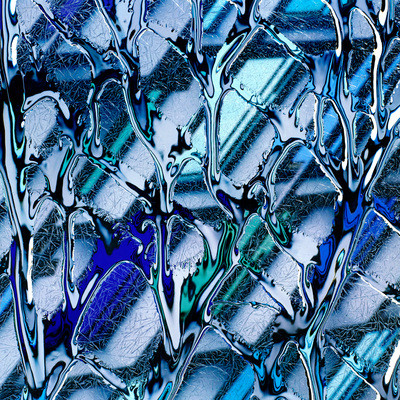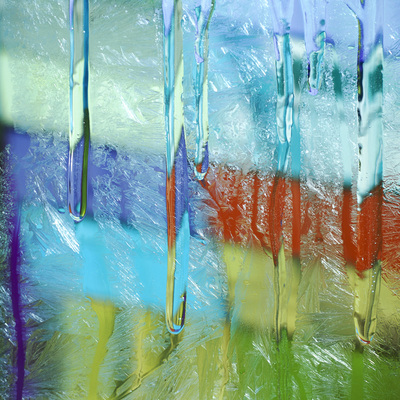CAROL INEZ CHARNEY
Artist Statement
_Carol Inez Charney's photographs are printed and face mounted on aluminum. Sizes come in 14x14", 20x20", 30x30", 40x40" and 60x60". Prices vary per image and addition size.
In Interior Landscape, I use natural distortions present in our everyday world—namely, moisture on glass—to evoke a painterly image that recontextualizes our everyday architectural landscape. While focusing on the minute details created from the juxtaposition of the water in the foreground and the architectural landscape in the background, we enter into a space of quiet reflection, which simultaneously inspires a new kind of internal and external vision.
After several years of combining painting and photography with mixed results, one very cold day in Minnesota I looked through a window completely covered in condensation–out to the distant frosty landscape. I realized I could use the camera to reinterpret the world around me into a form akin to that of painting. It was a paradigm shift for me in the way I saw all landscape from that point on; now I digitally photograph contemporary urban architecture and its inherent grids, distilling them down to a series of compositional planes.
I then obscure this composition by rephotographing the images back onto medium format film through water-coated glass, thus juxtaposing painterly abstraction with photographic realism. I chose to rephotograph the images back onto film because of film’s crispness, beauty, and the occasional lucky processing-magic that happens in a darkroom.
In rejecting traditional photographic representation, I’m approaching the urban architectural landscape as a canvas for reinterpreting and inventing my own form of landscape through a series of fractured planes and grids. I’m interested in how different materials such as water, and more recently ice, transform what I see and then create their own types of abstractions. In addition, in my process I’m systematically exploring shifting points of view within the architectural grid to create compositional studies that are more commonly found in painting rather than in photography.
In a fraction of a second, the camera has the ability to capture unadulterated realism, while through the veil of a stream of water the selective focus of the camera’s lens allows for the painterly abstraction to simultaneously exist. Transported to a contemplative state that becomes more profound each time we view the work, these Interior Landscapes become visual meditations. In this way, I’m simulating the experience of looking at a painting that is actually a photograph.
When looking at a painting, I’m drawn into the composition, and given the opportunity, to first explore the overall piece, and second, to further examine its details and materiality. It is during this second viewing, this deeper investigation, that the painting really pulls me in, and I begin to notice things I hadn’t the first time around. This is where I begin my internal dialogue, and where I’m transported to an introspective state that becomes more profound each time I view the work. It’s like a visual trance. This is the painterly experience that I now create, via photographic means, in my Interior Landscape series.
In Interior Landscape, I use natural distortions present in our everyday world—namely, moisture on glass—to evoke a painterly image that recontextualizes our everyday architectural landscape. While focusing on the minute details created from the juxtaposition of the water in the foreground and the architectural landscape in the background, we enter into a space of quiet reflection, which simultaneously inspires a new kind of internal and external vision.
After several years of combining painting and photography with mixed results, one very cold day in Minnesota I looked through a window completely covered in condensation–out to the distant frosty landscape. I realized I could use the camera to reinterpret the world around me into a form akin to that of painting. It was a paradigm shift for me in the way I saw all landscape from that point on; now I digitally photograph contemporary urban architecture and its inherent grids, distilling them down to a series of compositional planes.
I then obscure this composition by rephotographing the images back onto medium format film through water-coated glass, thus juxtaposing painterly abstraction with photographic realism. I chose to rephotograph the images back onto film because of film’s crispness, beauty, and the occasional lucky processing-magic that happens in a darkroom.
In rejecting traditional photographic representation, I’m approaching the urban architectural landscape as a canvas for reinterpreting and inventing my own form of landscape through a series of fractured planes and grids. I’m interested in how different materials such as water, and more recently ice, transform what I see and then create their own types of abstractions. In addition, in my process I’m systematically exploring shifting points of view within the architectural grid to create compositional studies that are more commonly found in painting rather than in photography.
In a fraction of a second, the camera has the ability to capture unadulterated realism, while through the veil of a stream of water the selective focus of the camera’s lens allows for the painterly abstraction to simultaneously exist. Transported to a contemplative state that becomes more profound each time we view the work, these Interior Landscapes become visual meditations. In this way, I’m simulating the experience of looking at a painting that is actually a photograph.
When looking at a painting, I’m drawn into the composition, and given the opportunity, to first explore the overall piece, and second, to further examine its details and materiality. It is during this second viewing, this deeper investigation, that the painting really pulls me in, and I begin to notice things I hadn’t the first time around. This is where I begin my internal dialogue, and where I’m transported to an introspective state that becomes more profound each time I view the work. It’s like a visual trance. This is the painterly experience that I now create, via photographic means, in my Interior Landscape series.













